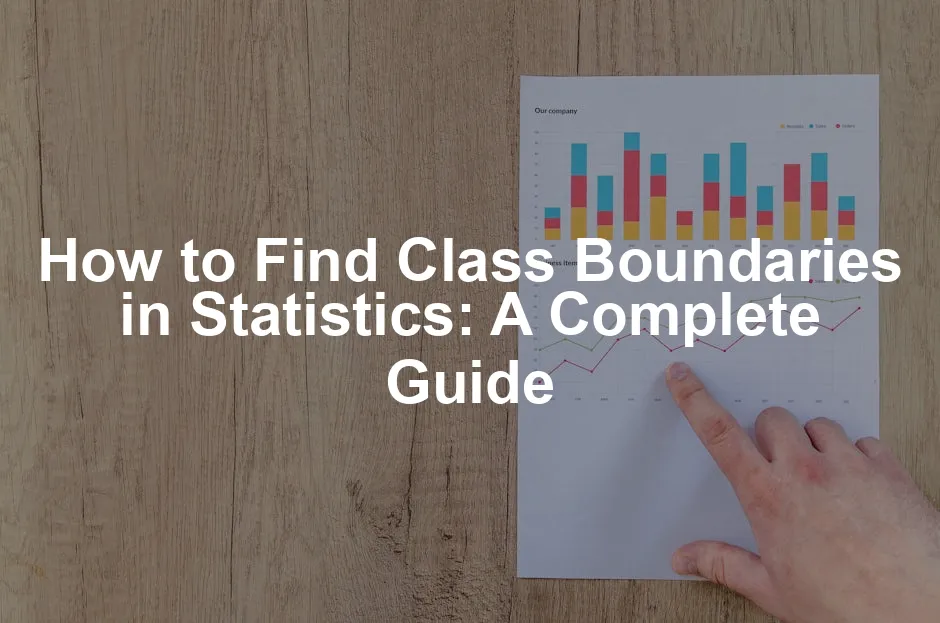4. Calculate Boundaries:
- For the first class (0 – 49):
- Lower boundary: 0 – 0.5 = -0.5
- Upper boundary: 49 + 0.5 = 49.5
- For the second class (50 – 59):
- Lower boundary: 50 – 0.5 = 49.5
- Upper boundary: 59 + 0.5 = 59.5
- For the third class (60 – 69):
- Lower boundary: 60 – 0.5 = 59.5
- Upper boundary: 69 + 0.5 = 69.5
- For the fourth class (70 – 79):
- Lower boundary: 70 – 0.5 = 69.5
- Upper boundary: 79 + 0.5 = 79.5
- For the fifth class (80 – 100):
- Lower boundary: 80 – 0.5 = 79.5
- Upper boundary: 100 + 0.5 = 100.5
Visualization: Here’s a table summarizing the class limits and their corresponding class boundaries:
| Score Group | Class Limits | Class Boundaries |
|---|---|---|
| 0 – 49 | 0 – 49 | -0.5 – 49.5 |
| 50 – 59 | 50 – 59 | 49.5 – 59.5 |
| 60 – 69 | 60 – 69 | 59.5 – 69.5 |
| 70 – 79 | 70 – 79 | 69.5 – 79.5 |
| 80 – 100 | 80 – 100 | 79.5 – 100.5 |
Each class boundary allows us to categorize test scores without any confusion or overlap. This clarity is crucial when analyzing performance across different score ranges.
In conclusion, understanding how to find class boundaries is essential for effective data analysis. It allows us to represent data accurately while ensuring that all values are accounted for in their respective categories. By using real-life examples like test scores, we can see the practical utility of this statistical concept. Next, we’ll explore some common mistakes and misunderstandings associated with class boundaries.

Common Mistakes and Misunderstandings
FAQs about Class Boundaries
What is the difference between class limits and class boundaries?
Class limits are the smallest and largest values within a class. Class boundaries, however, define the limits that separate classes without gaps. Think of class limits as the fences around a yard. The fences keep things organized, but class boundaries are like the invisible lines that ensure no stray balls end up in the neighbors’ yard!
Why do we use class boundaries?
Class boundaries are crucial for accurate data representation. They help eliminate gaps between classes, ensuring a seamless categorization of continuous data. Imagine trying to organize a sock drawer. Without class boundaries, those socks could easily get lost between the gaps, making it tough to find matching pairs!
How do class boundaries affect data analysis?
Class boundaries enhance data interpretation. They allow statisticians to visualize data accurately and compute measures like the mean or standard deviation effectively. If we didn’t have these boundaries, interpreting the data would feel like navigating a corn maze—confusing and chaotic!
Common Mistakes in Calculating Class Boundaries
Calculating class boundaries can trip up even the best of us. Here are some common pitfalls to avoid:
- Ignoring Half the Gap Calculation: A frequent mistake is forgetting to divide the gap between class limits by two. This half-gap ensures that boundaries are accurately placed, creating a smooth transition between classes.
- Confusing Upper and Lower Limits: It’s all too easy to mix up the upper limit of one class with the lower limit of the next. Always double-check that you’re working with the correct limits before making any adjustments.
- Failing to Adjust for Continuous Data: When dealing with continuous data, many forget to adjust class limits to eliminate overlaps. This adjustment is vital for accurate analysis.
- Overlooking Decimal Values: Some calculations may yield decimal boundaries. Failing to account for these can lead to imprecise data representation. Don’t be shy—embrace those decimal points!
- Misunderstanding Class Width: Confusion can arise when calculating class width. Remember, class width is the difference between the upper and lower limits. Miscalculating this can throw off your entire boundary setup.
By being aware of these common mistakes, you can avoid falling into these traps. Now that you have a clearer understanding of class boundaries and the frequent pitfalls to avoid, you’re well on your way to achieving accurate statistical analysis!

If you’re also looking to improve your overall study habits and stay organized, consider a Planner. It’s a game changer for keeping track of your assignments and deadlines!
Conclusion
Class boundaries are essential in statistics, ensuring that data is effectively categorized and analyzed. By avoiding common mistakes and understanding the FAQs surrounding class boundaries, you empower yourself to tackle statistical challenges with confidence. As you practice, remember to keep an eye out for those pesky gaps and overlaps! Happy calculating!
Additional Resources
If you’re looking to expand your knowledge on class boundaries and related statistical concepts, here are some great resources:
- How to Find Class Midpoints
- How to Find Class Limits
- Class Width Calculator
- Statistical Analysis with Excel
For textbooks, consider titles like “Statistics for Business and Economics” or “The Art of Statistics: Learning from Data.” Online courses from platforms like Coursera or edX also provide in-depth insights into statistics and data analysis.
Please let us know what you think about our content by leaving a comment down below!
Thank you for reading till here 🙂
Understanding class boundaries can significantly enhance your statistical analysis skills. For a deeper dive into the concept, check out this comprehensive guide on statistics class boundaries.
To further understand the concept of mean in statistics, you can explore what it means to be mean identically distributed in statistics.
All images from Pexels
4. Calculate Boundaries:
- For the first class (0 – 9):
- Lower boundary: 0 – 0.5 = -0.5
- Upper boundary: 9 + 0.5 = 9.5
- For the second class (10 – 19):
- Lower boundary: 10 – 0.5 = 9.5
- Upper boundary: 19 + 0.5 = 19.5
- For the third class (20 – 29):
- Lower boundary: 20 – 0.5 = 19.5
- Upper boundary: 29 + 0.5 = 29.5
- For the fourth class (30 – 39):
- Lower boundary: 30 – 0.5 = 29.5
- Upper boundary: 39 + 0.5 = 39.5
- For the fifth class (40 – 49):
- Lower boundary: 40 – 0.5 = 39.5
- Upper boundary: 49 + 0.5 = 49.5
Visualization: Let’s summarize the class limits and their corresponding class boundaries in a table.
| Age Group | Class Limits | Class Boundaries |
|---|---|---|
| 0 – 9 | 0 – 9 | -0.5 – 9.5 |
| 10 – 19 | 10 – 19 | 9.5 – 19.5 |
| 20 – 29 | 20 – 29 | 19.5 – 29.5 |
| 30 – 39 | 30 – 39 | 29.5 – 39.5 |
| 40 – 49 | 40 – 49 | 39.5 – 49.5 |
This table clearly shows how the class boundaries provide a seamless transition between age groups, avoiding any gaps. Each boundary overlaps with the next, ensuring every possible age is categorized correctly.
In summary, class boundaries are essential for avoiding overlaps or gaps in frequency distributions. By calculating these boundaries, we can ensure that our data is organized and analyzed accurately. Understanding this concept helps in visualizing data better and performing further statistical analysis. Up next, let’s take a look at a real-world application of this concept with a dataset that’s closer to our everyday lives.

Example 2: Real-World Application
Now, let’s shift gears and take a look at a real-world application of class boundaries using a dataset that most people can relate to: test scores from a recent examination.
Data Set: Assume we have the following frequency distribution of test scores:
| Score Group | Frequency |
|---|---|
| 0 – 49 | 10 |
| 50 – 59 | 15 |
| 60 – 69 | 20 |
| 70 – 79 | 25 |
| 80 – 100 | 30 |
Calculation: Now, let’s calculate the class boundaries for these score groups. We’ll follow the same steps as before.
1. Identify Class Limits: The upper limit of the first class is 49, and the lower limit of the second class is 50.
2. Calculate the Gap: The gap between these limits is 50 – 49 = 1.
3. Determine Half the Gap: Half of this gap is 1 / 2 = 0.5.
4. Calculate Boundaries:
- For the first class (0 – 49):
- Lower boundary: 0 – 0.5 = -0.5
- Upper boundary: 49 + 0.5 = 49.5
- For the second class (50 – 59):
- Lower boundary: 50 – 0.5 = 49.5
- Upper boundary: 59 + 0.5 = 59.5
- For the third class (60 – 69):
- Lower boundary: 60 – 0.5 = 59.5
- Upper boundary: 69 + 0.5 = 69.5
- For the fourth class (70 – 79):
- Lower boundary: 70 – 0.5 = 69.5
- Upper boundary: 79 + 0.5 = 79.5
- For the fifth class (80 – 100):
- Lower boundary: 80 – 0.5 = 79.5
- Upper boundary: 100 + 0.5 = 100.5
Visualization: Here’s a table summarizing the class limits and their corresponding class boundaries:
| Score Group | Class Limits | Class Boundaries |
|---|---|---|
| 0 – 49 | 0 – 49 | -0.5 – 49.5 |
| 50 – 59 | 50 – 59 | 49.5 – 59.5 |
| 60 – 69 | 60 – 69 | 59.5 – 69.5 |
| 70 – 79 | 70 – 79 | 69.5 – 79.5 |
| 80 – 100 | 80 – 100 | 79.5 – 100.5 |
Each class boundary allows us to categorize test scores without any confusion or overlap. This clarity is crucial when analyzing performance across different score ranges.
In conclusion, understanding how to find class boundaries is essential for effective data analysis. It allows us to represent data accurately while ensuring that all values are accounted for in their respective categories. By using real-life examples like test scores, we can see the practical utility of this statistical concept. Next, we’ll explore some common mistakes and misunderstandings associated with class boundaries.

Common Mistakes and Misunderstandings
FAQs about Class Boundaries
What is the difference between class limits and class boundaries?
Class limits are the smallest and largest values within a class. Class boundaries, however, define the limits that separate classes without gaps. Think of class limits as the fences around a yard. The fences keep things organized, but class boundaries are like the invisible lines that ensure no stray balls end up in the neighbors’ yard!
Why do we use class boundaries?
Class boundaries are crucial for accurate data representation. They help eliminate gaps between classes, ensuring a seamless categorization of continuous data. Imagine trying to organize a sock drawer. Without class boundaries, those socks could easily get lost between the gaps, making it tough to find matching pairs!
How do class boundaries affect data analysis?
Class boundaries enhance data interpretation. They allow statisticians to visualize data accurately and compute measures like the mean or standard deviation effectively. If we didn’t have these boundaries, interpreting the data would feel like navigating a corn maze—confusing and chaotic!
Common Mistakes in Calculating Class Boundaries
Calculating class boundaries can trip up even the best of us. Here are some common pitfalls to avoid:
- Ignoring Half the Gap Calculation: A frequent mistake is forgetting to divide the gap between class limits by two. This half-gap ensures that boundaries are accurately placed, creating a smooth transition between classes.
- Confusing Upper and Lower Limits: It’s all too easy to mix up the upper limit of one class with the lower limit of the next. Always double-check that you’re working with the correct limits before making any adjustments.
- Failing to Adjust for Continuous Data: When dealing with continuous data, many forget to adjust class limits to eliminate overlaps. This adjustment is vital for accurate analysis.
- Overlooking Decimal Values: Some calculations may yield decimal boundaries. Failing to account for these can lead to imprecise data representation. Don’t be shy—embrace those decimal points!
- Misunderstanding Class Width: Confusion can arise when calculating class width. Remember, class width is the difference between the upper and lower limits. Miscalculating this can throw off your entire boundary setup.
By being aware of these common mistakes, you can avoid falling into these traps. Now that you have a clearer understanding of class boundaries and the frequent pitfalls to avoid, you’re well on your way to achieving accurate statistical analysis!

If you’re also looking to improve your overall study habits and stay organized, consider a Planner. It’s a game changer for keeping track of your assignments and deadlines!
Conclusion
Class boundaries are essential in statistics, ensuring that data is effectively categorized and analyzed. By avoiding common mistakes and understanding the FAQs surrounding class boundaries, you empower yourself to tackle statistical challenges with confidence. As you practice, remember to keep an eye out for those pesky gaps and overlaps! Happy calculating!
Additional Resources
If you’re looking to expand your knowledge on class boundaries and related statistical concepts, here are some great resources:
- How to Find Class Midpoints
- How to Find Class Limits
- Class Width Calculator
- Statistical Analysis with Excel
For textbooks, consider titles like “Statistics for Business and Economics” or “The Art of Statistics: Learning from Data.” Online courses from platforms like Coursera or edX also provide in-depth insights into statistics and data analysis.
Please let us know what you think about our content by leaving a comment down below!
Thank you for reading till here 🙂
Understanding class boundaries can significantly enhance your statistical analysis skills. For a deeper dive into the concept, check out this comprehensive guide on statistics class boundaries.
To further understand the concept of mean in statistics, you can explore what it means to be mean identically distributed in statistics.
All images from Pexels
Introduction
Class boundaries are pivotal in statistics. They help organize continuous data into intervals without gaps. Imagine you’re throwing a birthday party. You want to group your friends by age, ensuring everyone fits snugly into their respective age categories. Class boundaries do just that!
When we gather data, particularly continuous data, it’s crucial to avoid overlaps and gaps. Class boundaries act as the invisible lines that define these intervals. They ensure no data points are left hanging in the void. This article aims to illuminate the definition of class boundaries, the methods to calculate them, and practical examples to make the concept crystal clear.
By the end of this guide, you’ll be equipped with the knowledge to find class boundaries confidently. Whether you’re analyzing test scores, heights, or any continuous dataset, these boundaries will help you make sense of your data. Let’s get started on this mathematical adventure!
Speaking of adventures, if you’re looking to keep your data organized and stylish, consider grabbing a Data Organizer. It’s like a closet for your data—everything in its place and easy to find!

Understanding Class Boundaries
What are Class Boundaries?
Class boundaries are defined as the limits that separate different classes in a frequency distribution. They are not to be confused with class limits. Class limits are the smallest and largest values that can be included in each class. In contrast, class boundaries eliminate any gaps between these classes, making them essential for continuous data.
Picture a busy highway with lanes. Each lane represents a class, while the boundaries are the painted lines that keep vehicles in their respective lanes. Class boundaries ensure that data points are categorized correctly without overlap or ambiguity.
Why are class boundaries crucial, especially for continuous data? Without them, we could mistakenly categorize values. For instance, consider a data set of heights ranging from 150 cm to 200 cm. If we create classes like 150-159 cm and 160-169 cm without proper boundaries, a height of 159.5 cm might cause confusion. Is it categorized in the first or second class? Class boundaries dodge such conundrums.
In frequency distributions, applying class boundaries leads to better representation of data. It allows for accurate calculations of measures like the mean and standard deviation. Histograms, which visually represent frequency distributions, also rely on these boundaries to display data clearly.
To summarize, class boundaries play a vital role in providing clarity and accuracy in statistical analysis. They ensure that data is organized effectively, paving the way for insightful interpretations. So, let’s keep these boundaries in mind as we dive deeper into calculating them!
And speaking of clarity, if you find yourself needing a little help with your calculations, a Scientific Calculator might just be the tool you need. It’s like having a personal math assistant right in your pocket!

Key Terms and Concepts
Understanding class boundaries begins with familiarizing yourself with key terms. These concepts are vital for mastering the art of data organization in statistics. Let’s break them down!
Class Limits
Class limits are the smallest and largest values that can exist in a class. Each class has a lower class limit (the smallest value) and an upper class limit (the largest value). Think of it as a cozy little house: the lower limit is the front door, and the upper limit is the back door. Only values within this range are allowed in! For instance, if we have a class limit of 10-20, then 10 is the lower limit, and 20 is the upper limit. Understanding these limits ensures no data point is left outside the house!
Class Width
Class width refers to the difference between the upper and lower limits of a class. It’s calculated by subtracting the lower limit from the upper limit. Using our previous example, the class width for 10-20 is 20 – 10 = 10. This width is crucial when establishing class boundaries. Wider classes can accommodate a more extensive range of data, but they may also obscure details. So, find a balance!
Class Midpoint
The class midpoint is the average of the upper and lower limits in a class. It’s a handy little number that gives you a sense of the “center” of the class. For our 10-20 class, the midpoint is (10 + 20) / 2 = 15. Midpoints can help summarize data and make calculations easier, especially when analyzing frequency distributions. They are like the cherry on top of a data sundae, adding sweetness without overwhelming the flavor!
Now, how do these concepts tie into class boundaries? Well, class boundaries serve as the critical separators between classes. They ensure that data points are correctly categorized without gaps or overlaps. Class boundaries are calculated by adjusting the class limits slightly. This adjustment involves subtracting and adding half the gap between the upper limit of one class and the lower limit of the next. This way, all data points neatly fall into place, just like perfectly fitting puzzle pieces.
In summary, class limits, class width, and class midpoints are foundational concepts in statistics that set the stage for understanding class boundaries. They help create a clear and organized frequency distribution, which is essential for accurate data analysis. So, keep these terms handy as we move forward. Getting familiar with them will make calculating class boundaries feel like a breeze!

Example 1: Simple Frequency Distribution
To understand class boundaries, let’s consider a simple frequency distribution example. We’ll use a dataset representing the ages of a group of people attending a community event. Here’s how we can calculate the class boundaries from this data.
Data Set: Imagine we have the following age groups as our frequency distribution:
| Age Group | Frequency |
|---|---|
| 0 – 9 | 5 |
| 10 – 19 | 8 |
| 20 – 29 | 6 |
| 30 – 39 | 4 |
| 40 – 49 | 3 |
Calculation: Now, let’s calculate the class boundaries for each of these classes. To do this, we’ll follow a few simple steps:
1. Identify Class Limits: The upper limit of the first class is 9, and the lower limit of the second class is 10.
2. Calculate the Gap: The gap between these limits is 10 – 9 = 1.
3. Determine Half the Gap: Half of this gap is 1 / 2 = 0.5.
4. Calculate Boundaries:
- For the first class (0 – 9):
- Lower boundary: 0 – 0.5 = -0.5
- Upper boundary: 9 + 0.5 = 9.5
- For the second class (10 – 19):
- Lower boundary: 10 – 0.5 = 9.5
- Upper boundary: 19 + 0.5 = 19.5
- For the third class (20 – 29):
- Lower boundary: 20 – 0.5 = 19.5
- Upper boundary: 29 + 0.5 = 29.5
- For the fourth class (30 – 39):
- Lower boundary: 30 – 0.5 = 29.5
- Upper boundary: 39 + 0.5 = 39.5
- For the fifth class (40 – 49):
- Lower boundary: 40 – 0.5 = 39.5
- Upper boundary: 49 + 0.5 = 49.5
Visualization: Let’s summarize the class limits and their corresponding class boundaries in a table.
| Age Group | Class Limits | Class Boundaries |
|---|---|---|
| 0 – 9 | 0 – 9 | -0.5 – 9.5 |
| 10 – 19 | 10 – 19 | 9.5 – 19.5 |
| 20 – 29 | 20 – 29 | 19.5 – 29.5 |
| 30 – 39 | 30 – 39 | 29.5 – 39.5 |
| 40 – 49 | 40 – 49 | 39.5 – 49.5 |
This table clearly shows how the class boundaries provide a seamless transition between age groups, avoiding any gaps. Each boundary overlaps with the next, ensuring every possible age is categorized correctly.
In summary, class boundaries are essential for avoiding overlaps or gaps in frequency distributions. By calculating these boundaries, we can ensure that our data is organized and analyzed accurately. Understanding this concept helps in visualizing data better and performing further statistical analysis. Up next, let’s take a look at a real-world application of this concept with a dataset that’s closer to our everyday lives.

Example 2: Real-World Application
Now, let’s shift gears and take a look at a real-world application of class boundaries using a dataset that most people can relate to: test scores from a recent examination.
Data Set: Assume we have the following frequency distribution of test scores:
| Score Group | Frequency |
|---|---|
| 0 – 49 | 10 |
| 50 – 59 | 15 |
| 60 – 69 | 20 |
| 70 – 79 | 25 |
| 80 – 100 | 30 |
Calculation: Now, let’s calculate the class boundaries for these score groups. We’ll follow the same steps as before.
1. Identify Class Limits: The upper limit of the first class is 49, and the lower limit of the second class is 50.
2. Calculate the Gap: The gap between these limits is 50 – 49 = 1.
3. Determine Half the Gap: Half of this gap is 1 / 2 = 0.5.
4. Calculate Boundaries:
- For the first class (0 – 49):
- Lower boundary: 0 – 0.5 = -0.5
- Upper boundary: 49 + 0.5 = 49.5
- For the second class (50 – 59):
- Lower boundary: 50 – 0.5 = 49.5
- Upper boundary: 59 + 0.5 = 59.5
- For the third class (60 – 69):
- Lower boundary: 60 – 0.5 = 59.5
- Upper boundary: 69 + 0.5 = 69.5
- For the fourth class (70 – 79):
- Lower boundary: 70 – 0.5 = 69.5
- Upper boundary: 79 + 0.5 = 79.5
- For the fifth class (80 – 100):
- Lower boundary: 80 – 0.5 = 79.5
- Upper boundary: 100 + 0.5 = 100.5
Visualization: Here’s a table summarizing the class limits and their corresponding class boundaries:
| Score Group | Class Limits | Class Boundaries |
|---|---|---|
| 0 – 49 | 0 – 49 | -0.5 – 49.5 |
| 50 – 59 | 50 – 59 | 49.5 – 59.5 |
| 60 – 69 | 60 – 69 | 59.5 – 69.5 |
| 70 – 79 | 70 – 79 | 69.5 – 79.5 |
| 80 – 100 | 80 – 100 | 79.5 – 100.5 |
Each class boundary allows us to categorize test scores without any confusion or overlap. This clarity is crucial when analyzing performance across different score ranges.
In conclusion, understanding how to find class boundaries is essential for effective data analysis. It allows us to represent data accurately while ensuring that all values are accounted for in their respective categories. By using real-life examples like test scores, we can see the practical utility of this statistical concept. Next, we’ll explore some common mistakes and misunderstandings associated with class boundaries.

Common Mistakes and Misunderstandings
FAQs about Class Boundaries
What is the difference between class limits and class boundaries?
Class limits are the smallest and largest values within a class. Class boundaries, however, define the limits that separate classes without gaps. Think of class limits as the fences around a yard. The fences keep things organized, but class boundaries are like the invisible lines that ensure no stray balls end up in the neighbors’ yard!
Why do we use class boundaries?
Class boundaries are crucial for accurate data representation. They help eliminate gaps between classes, ensuring a seamless categorization of continuous data. Imagine trying to organize a sock drawer. Without class boundaries, those socks could easily get lost between the gaps, making it tough to find matching pairs!
How do class boundaries affect data analysis?
Class boundaries enhance data interpretation. They allow statisticians to visualize data accurately and compute measures like the mean or standard deviation effectively. If we didn’t have these boundaries, interpreting the data would feel like navigating a corn maze—confusing and chaotic!
Common Mistakes in Calculating Class Boundaries
Calculating class boundaries can trip up even the best of us. Here are some common pitfalls to avoid:
- Ignoring Half the Gap Calculation: A frequent mistake is forgetting to divide the gap between class limits by two. This half-gap ensures that boundaries are accurately placed, creating a smooth transition between classes.
- Confusing Upper and Lower Limits: It’s all too easy to mix up the upper limit of one class with the lower limit of the next. Always double-check that you’re working with the correct limits before making any adjustments.
- Failing to Adjust for Continuous Data: When dealing with continuous data, many forget to adjust class limits to eliminate overlaps. This adjustment is vital for accurate analysis.
- Overlooking Decimal Values: Some calculations may yield decimal boundaries. Failing to account for these can lead to imprecise data representation. Don’t be shy—embrace those decimal points!
- Misunderstanding Class Width: Confusion can arise when calculating class width. Remember, class width is the difference between the upper and lower limits. Miscalculating this can throw off your entire boundary setup.
By being aware of these common mistakes, you can avoid falling into these traps. Now that you have a clearer understanding of class boundaries and the frequent pitfalls to avoid, you’re well on your way to achieving accurate statistical analysis!

If you’re also looking to improve your overall study habits and stay organized, consider a Planner. It’s a game changer for keeping track of your assignments and deadlines!
Conclusion
Class boundaries are essential in statistics, ensuring that data is effectively categorized and analyzed. By avoiding common mistakes and understanding the FAQs surrounding class boundaries, you empower yourself to tackle statistical challenges with confidence. As you practice, remember to keep an eye out for those pesky gaps and overlaps! Happy calculating!
Additional Resources
If you’re looking to expand your knowledge on class boundaries and related statistical concepts, here are some great resources:
- How to Find Class Midpoints
- How to Find Class Limits
- Class Width Calculator
- Statistical Analysis with Excel
For textbooks, consider titles like “Statistics for Business and Economics” or “The Art of Statistics: Learning from Data.” Online courses from platforms like Coursera or edX also provide in-depth insights into statistics and data analysis.
Please let us know what you think about our content by leaving a comment down below!
Thank you for reading till here 🙂
Understanding class boundaries can significantly enhance your statistical analysis skills. For a deeper dive into the concept, check out this comprehensive guide on statistics class boundaries.
To further understand the concept of mean in statistics, you can explore what it means to be mean identically distributed in statistics.
All images from Pexels




